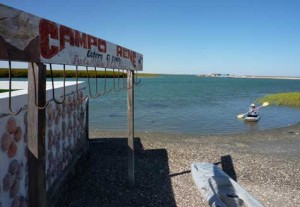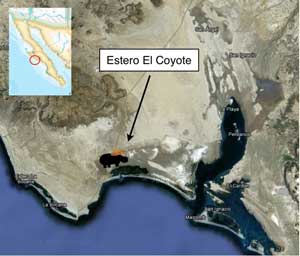Voyage of Kiri blogger Kristian Beadle discovers the beauty of mangroves and recognizes the ecological peril climate change puts them in.
Location: An estuary near Punta Abreojos, on the Pacific coast of Baja.
Conditions: A full moon is rising to the east.
Discussion: The wind and dust were unrelenting. It had become an impish presence, prodding your ribs, harassing your scalp, speckling dirt in your cup of tea when you looked away. By the 10th day of the atmospheric assault, we retreated to an estuary-side campground with nice palapas at Estero el Coyote, 15 miles from Punta Abreojos and its fishing cooperative.

Our spot was next to the estuary with views of the mangrove forest. At low tide, the mangrove roots stuck out like thick spiderwebs rising from the mud, glistening with moisture; at high tide the leaves and branches were feeling the lap of the turbulent water. We rented some discounted — and leaking — kayaks to navigate through the mangroves. Their intake of water created a pleasant problem: having to clamber onto mudflats, good observation points for fauna and flora, to regularly dump the uninvited liquid. We could hear the din of birds inside the mangrove, hundreds of them, visible only when we peered through the overhanging foliage or as they suddenly took to flight.
This estuary is the northern-most limit of mangroves along the Pacific coast (save for another small zone past Abreojos); while on the Sea of Cortéz, the northern-most limit were islands in Bahia de los Angeles, a network of protected areas we previously visited. Mangroves are a famous kind of tree: Appearing only in the sub-tropics and tropics, they reside in a mixture of salt and freshwater, providing a nursery habitat for an incredible number of fish and they are critical for migratory birds.

Economically, they are extremely valuable — a 2006 United Nations report estimates a hectare (roughly 2.5 acres) of mangrove is worth between $200 million and $900 million USD per year based on its role in sustaining commercial fish. (It’s worth noting that two-thirds of the seafood that people eat has lived in a mangrove for a stage of its life). That figure does not count the infrastructure savings, since mangroves filter toxins from waterways, protect coastlines from storms and store carbon.
Nonetheless, mangroves are the most threatened coastal ecosystem in the world; 50 percent of the global total has been removed during this century, and the rest are slowly being weakened by human development.
Having dinner in our palapa, Alyssum and I felt disheveled after all those days of dust and wind. We were out of the desert’s teeth, with good shelter and a “luxurious” shower at Campo Renée, but the unsettled mood pervaded. We bickered about what food to eat and how the ice was running out.

I wondered whether mangroves bicker when they are afflicted by pollution or poor water flow. “I’m sick of all this siltation. Move over so I can breathe!” one tree might say to another. Deforestation and the erosion that follows tend to “suffocate” mangroves with silt. They might gasp and complain, “Where is the freshwater?” Roads can block the natural water flow, and dams divert river water for irrigation and cities. Hyper-salinated, the shriveled mangroves might squabble about what to eat, too.
Studies indicate that sea level rise will be another point of stress: Too much water can make mangroves more vulnerable to storms and over-salinity, which forces them “’uphill” to higher ground (and hopefully, a better mix of freshwater). However, the rate of sea level rise appears to be faster than the rate of mangrove migration in areas where sediments are not readily available for new recruitment. Furthermore, the practice of filling wetlands areas with dirt — used for agriculture, roads and buildings — prevents the landward movement of mangroves in their quest for balanced inundation and salinity. Like us, they need room to breathe when they are squeezed.
The U.N. report recommends reducing land pollution (e.g. agro-chemicals, trash) and maintaining the same hydrological regimen (not filling wetlands, not carving artificial channels) to keep the mangroves healthy and improve their chance of survival.
Incidentally, healthy mangroves are excellent at mitigating climate change by absorbing the most carbon of any natural ecosystem — around 30 tons per hectacre per year, according to a 2008 study. The possibility of financing mangrove conservation for carbon offsets is being studied by groups such as Earthwatch, funded by insurance group Aviva, part of an industry that is increasingly aware of the risks involved with mangrove depletion. Using mangroves for carbon capture could also help feed people, as described in a 2007 National Geographicarticle. That being said, we might still need to find a better way to farm shrimp …
The mangroves at Estero el Coyote are not squabbling; they are quiet and healthy. In the mid-’90s, the local fishing cooperative and conservation groups halted a proposed salt processing operation — an alliance that began the Punta Abreojos Coastkeeper. Since then, the only uses in the estuary are seasonal sportfishing and small-scale oyster farming. Our spirits lifted as we soaked in the calm diurnal flow of the estuary and the mangroves. The good news is, given the right water flow, even worn-out mangroves can bounce back quickly, like we did.



